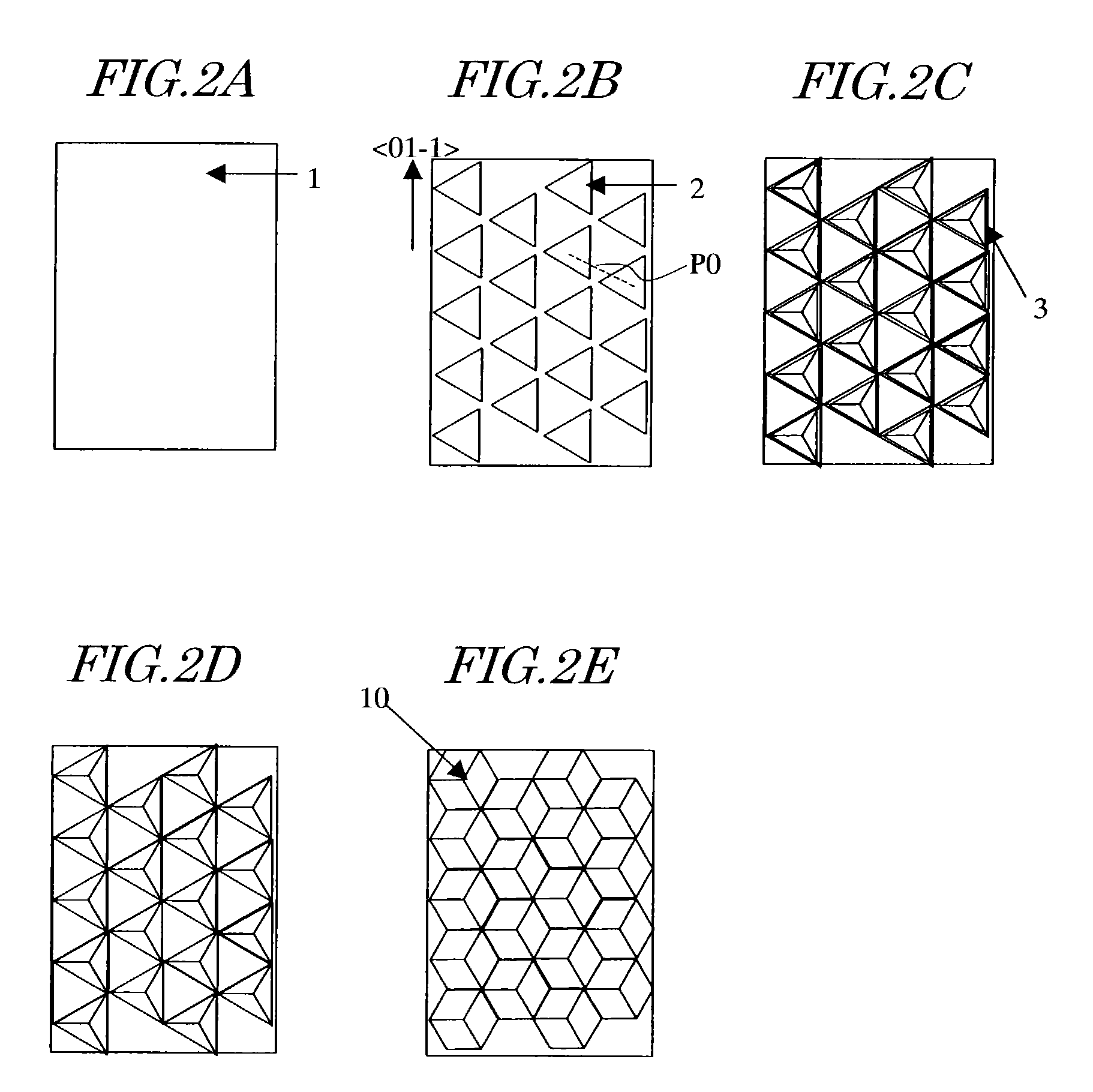Corner cube array and method of making the corner cube array
a technology of corner cubes and arrays, which is applied in the field of corner cube arrays and a method of making corner cube arrays, can solve the problems of difficult to make an array of corner cubes, difficult to make a corner cube of a small size, and the prism to be formed by this method cannot have any other shape, etc., and achieves the effect of high shape precision and small siz
- Summary
- Abstract
- Description
- Claims
- Application Information
AI Technical Summary
Benefits of technology
Problems solved by technology
Method used
Image
Examples
embodiment 1
[0063]In a first specific preferred embodiment of the present invention, a substrate, made up of GaAs crystals having a sphalerite structure, is used as a cubic single crystalline substrate. The solid shape elements are formed on this substrate by a wet etching process so as to define a predetermined pattern thereon, and then an anisotropic crystal growth process is carried out on the solid shape elements on the substrate, thereby forming a micro corner cube array thereon.
[0064]FIGS. 1A through 1E and FIGS. 2A through 2E show respective process steps for making a micro corner cube array according to the first preferred embodiment of the present invention. First, as shown in FIGS. 1A and 2A, a GaAs substrate 1, of which the surface is substantially parallel to {111}B planes, is prepared, and has that surface mirror-polished. It should be noted that {111}A planes are formed by gallium atoms, while {111}B planes are formed by arsenic atoms.
[0065]Next, as shown in FIGS. 1B and 2B, the s...
embodiment 2
[0087]Hereinafter, a second specific preferred embodiment of the present invention will be described.
[0088]In this second preferred embodiment, solid shape elements (i.e., convex portions in this preferred embodiment also) are formed by a wet etching process so as to define a predetermined pattern on the surface of a GaAs substrate. Then, those solid shape elements are dry-etched while active species, including the elements contained in the crystalline material of the substrate, are supplied onto the substrate, thereby forming a micro corner cube array.
[0089]FIGS. 6A through 6E and FIGS. 7A through 7E show respective process steps for making a micro corner cube array according to the second preferred embodiment of the present invention. First, as shown in FIGS. 6A and 7A, a GaAs substrate 21, of which the surface is substantially parallel to {111}B planes, is prepared, and has that surface mirror-polished as in the first preferred embodiment described above.
[0090]Next, as shown in F...
embodiment 3
[0102]In the first and second preferred embodiments described above, in the process step of supplying the first active species, an anisotropic crystal growth process is carried out on the solid shape elements on the substrate, thereby forming a plurality of corner cube unit elements, each being made up of three crystal planes that are defined by {100} planes. However, just by performing such an anisotropic crystal growth process, other families of crystal planes may be left on the exposed surface of the substrate.
[0103]Specifically, in the process step of supplying the first active species according to the first or second preferred embodiment described above, unnecessary families of crystal planes, other than the {100} planes to be defined, likely remain around the vertices of the respective unit elements. Even if the surface of the substrate is further patterned (e.g., etched) to reduce the percentage of those unnecessary families of crystal planes, other unnecessary families of cr...
PUM
| Property | Measurement | Unit |
|---|---|---|
| Optical reflectivity | aaaaa | aaaaa |
| Size | aaaaa | aaaaa |
| Shape | aaaaa | aaaaa |
Abstract
Description
Claims
Application Information
 Login to View More
Login to View More - R&D
- Intellectual Property
- Life Sciences
- Materials
- Tech Scout
- Unparalleled Data Quality
- Higher Quality Content
- 60% Fewer Hallucinations
Browse by: Latest US Patents, China's latest patents, Technical Efficacy Thesaurus, Application Domain, Technology Topic, Popular Technical Reports.
© 2025 PatSnap. All rights reserved.Legal|Privacy policy|Modern Slavery Act Transparency Statement|Sitemap|About US| Contact US: help@patsnap.com



